Themed collection Organic Electronics – Ecofriendly and/or sustainable materials, processes, devices, and applications

Introduction to Organic Electronics – Ecofriendly and/or sustainable materials, processes, devices, and applications
Professor Gregory C. Welch introduces the Journal of Materials Chemistry C and Materials Advances joint themed collection on Organic Electronics – Ecofriendly and/or sustainable materials, processes, devices, and applications.

J. Mater. Chem. C, 2022,10, 2869-2869
https://doi.org/10.1039/D2TC90013K
Ubiquitous clean and sustainable energy-driven self-rechargeable batteries realized by and used in organic electronics
This article provides a review of various types of self-rechargeable batteries powered by ubiquitous clean and sustainable energy sources.
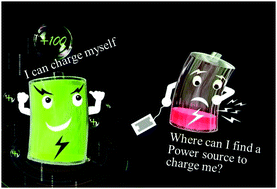
J. Mater. Chem. C, 2022,10, 388-412
https://doi.org/10.1039/D1TC04122C
Advances in applying C–H functionalization and naturally sourced building blocks in organic semiconductor synthesis
This review presents the recent advances in the synthesis of organic semiconductors using C–H functionalization and naturally sourced building blocks to facilitate the large-scale production and commercialization of organic semiconductors.
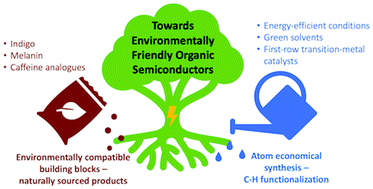
J. Mater. Chem. C, 2021,9, 16391-16409
https://doi.org/10.1039/D1TC04128B
Low-cost materials for organic solar cells
This review summarizes the recent advances in low-cost materials for OSCs from the aspects of the synthetic method, active materials, interfacial materials and processing solution.
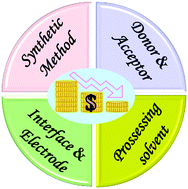
J. Mater. Chem. C, 2021,9, 15395-15406
https://doi.org/10.1039/D1TC04097A
Peptide-based novel small molecules and polymers: unexplored optoelectronic materials
Optoelectronic devices such as photovoltaics (solar cells), organic light-emitting diodes (OLEDs), thin-film transistors, and electrochromism based on peptide molecular/materials and their strategic design.
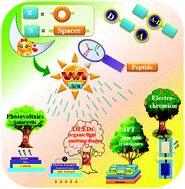
J. Mater. Chem. C, 2021,9, 12462-12488
https://doi.org/10.1039/D1TC03375A
An air-stable n-type bay-and-headland substituted bis-cyano N–H functionalized perylene diimide for printed electronics
Design, synthesis, and characterization of an electron deficient N-H functionalized perylene diimide, with halogen-free solvent solubility, for air-stable transistor operation.
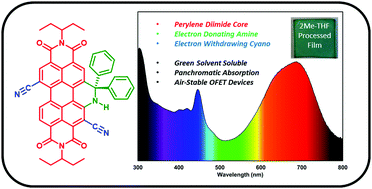
J. Mater. Chem. C, 2021,9, 13630-13634
https://doi.org/10.1039/D1TC03873G
Phosphorus-modified Pt@Cu surfaces for efficient electrocatalysis of hydrogen evolution
Phosphorus-modified Pt@Cu (Pt/P@Cu) was fabricated through a one-step method as a self-standing electrocatalyst, leading to increased surface activity sites, reduced charge transfer resistance and enhanced HER performance in neutral medium.
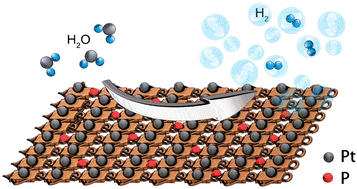
Mater. Adv., 2022,3, 7667-7672
https://doi.org/10.1039/D2MA00772J
A phenothiazine-fused electroactive bilayer helicene: design, synthesis, ACQ-to-AIE transformation and photophysical properties
Study of the photophysical, electrochemical and photoconductive properties of SPS-PY-PT and a comparative analysis with PY-PT-Un. In addition, the ACQ and AIE phenomena and time-resolved microwave conductivity (TRMC) are analysed.
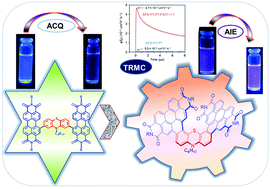
J. Mater. Chem. C, 2022,10, 5173-5182
https://doi.org/10.1039/D1TC06090B
Self-assembly of PBTTT–C14 thin films in supercritical fluids
In order to develop more atom-economical deposition methods for polymer semiconductors, we investigated physical supercritical fluid deposition (p-SFD) to form thin films of a popular bithiophene semiconducting polymer (PBTTT).
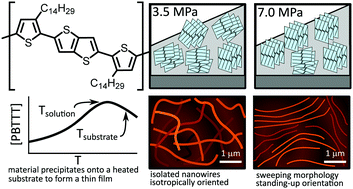
Mater. Adv., 2022,3, 2515-2523
https://doi.org/10.1039/D1MA00847A
Influence of pH-neutral lithium polystyrenesulfonate polyelectrolyte on the energy band structure and performance of organic solar cells
We investigate the effect of the polyelectrolyte lithium poly(styrene sulfonate) (Li:PSS) on the electronic band structure of organic solar cells and find that it functions as a hole transport layer, allowing improved efficiency and device stability.

Mater. Adv., 2022,3, 2123-2130
https://doi.org/10.1039/D1MA00913C
Chalcogen-substituted PCBM derivatives as ternary components in PM6:Y6 solar cells
Chalcogen-substituted PCBM derivatives are a promising approach to enhance power efficiency in ternary organic solar cells (TOSCs).
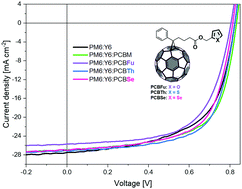
Mater. Adv., 2022,3, 1071-1078
https://doi.org/10.1039/D1MA00925G
Highly efficient hybrid light-emitting transistors incorporating MoOx/Ag/MoOx semi-transparent electrodes
Light-emitting transistors (LETs) couple the switching function of a transistor with the light-emitting function of LEDs. We demonstrate improved light out-coupling efficiency in LETs using oxide – metal – oxide type semitransparent electrodes.
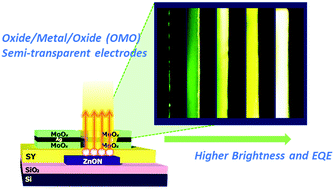
J. Mater. Chem. C, 2022,10, 880-885
https://doi.org/10.1039/D1TC04674H
2,9-Dibenzo[b,def]chrysene as a building block for organic electronics
A new series of three donor–acceptor conjugated polymers based on a low-cost, easily accessible vat dye called Vat orange 1 have been prepared. The polymers have bandgap values ranging from 1.61 to 1.86 eV.
![Graphical abstract: 2,9-Dibenzo[b,def]chrysene as a building block for organic electronics](/en/Image/Get?imageInfo.ImageType=GA&imageInfo.ImageIdentifier.ManuscriptID=D1MA00799H&imageInfo.ImageIdentifier.Year=2022)
Mater. Adv., 2022,3, 599-603
https://doi.org/10.1039/D1MA00799H
Temperature-dependent morphology-electron mobility correlations of naphthalene diimide-indacenodithiophene copolymers prepared via direct arylation polymerization
A series of defect-free n-type copolymers poly(naphthalene diimide-alt-indacenodithiophene) P(NDI-IDT) comprising alternating naphthalene diimide (NDI) and indacenodithiophene (IDT) units is prepared using atom-economic direct arylation polycondensation (DAP).
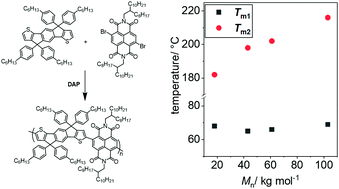
Mater. Adv., 2021,2, 7881-7890
https://doi.org/10.1039/D1MA00633A
Improving the charge transport performance of solution-processed organic field-effect transistors using green solvent additives
Green solvent additives were employed as non-solvents in binary solvent systems to enable the pre-aggregation of organic semiconductors and enhance the electrical performance of organic field-effect transistors and complementary-like inverters.
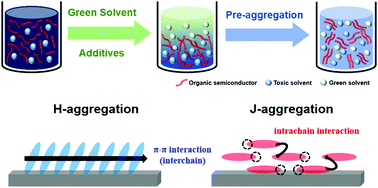
J. Mater. Chem. C, 2021,9, 16506-16515
https://doi.org/10.1039/D1TC03782J
Synthesis of push–pull triarylamine dyes containing 5,6-difluoro-2,1,3-benzothiadiazole units by direct arylation and their evaluation as active material for organic photovoltaics
Direct (hetero)-arylation was used to prepare two push–pull molecules. Optimization of the experimental coupling conditions and their preliminary evaluation as active materials in simple air-processed organic solar cells are reported herein.

Mater. Adv., 2021,2, 7456-7462
https://doi.org/10.1039/D1MA00798J
Fabrication of an autonomously self-healing flexible thin-film capacitor by slot-die coating
Flexible self-healing pressure sensors were prepared by slot-die onto a flexible substrate, and were characterized using multiple tools to investigate their response to mechanical deformation and their properties before and after self-healing.
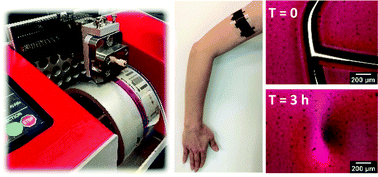
Mater. Adv., 2021,2, 6676-6683
https://doi.org/10.1039/D1MA00656H
Impact of subtle change in branched amino acid on the assembly and properties of perylene bisimides hydrogels
We investigate how apparent slight changes to the chemical structure of amino acid-functionalised perylene bisimides (PBIs) affect the self-assembled aggregates formed and their resulting physical and optical properties.
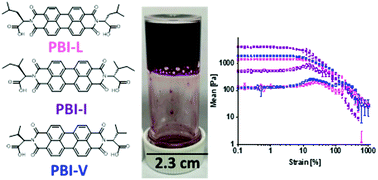
Mater. Adv., 2021,2, 5248-5253
https://doi.org/10.1039/D1MA00470K
About this collection
Guest Edited by Prof. Gregory C. Welch, University of Calgary.
Organic electronics is a fascinating field of study where conjugated materials can be tuned at the molecular scale to tailor properties for use in a myriad of advanced applications. Organic photovoltaics, transistors, light emitting didoes, photo detectors, batteries, supercapacitors, thermo electrics, and electrochromics are but a few technologies actively investigated.
This themed collection features articles from across this topic, including sustainable designs, atom-economical synthesis, green-solvent processing, low-power device operation, device bio-degradability/recyclability, up-scaling and next-generation applications for organic electronics in a sustainable world.